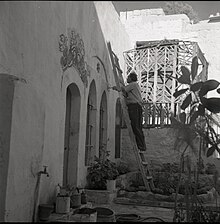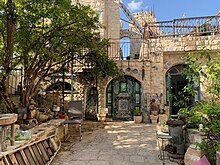Artists Quarter of Safed
 From Wikipedia the free encyclopedia
From Wikipedia the free encyclopedia

The Artists' Quarter in Safed, also known as the Artists' Colony; was founded after the capture of Safed, in the 1948 Arab–Israeli War.[1] With the encouragement of the Safed municipality, a group of artists began to restore ruins in the Muslim[2] neighborhood of Harat al-Wata,[3] on the border of the historic Jewish quarter, to build galleries and open exhibitions. The first artists to settle in Safed however arrived several years beforehand. The first to discover Safed's artistic aura was Isaac Frenkel Frenel in 1920 and following him Moshe Castel and Mordechai Levanon in the 1930s.
This attracted dozens of other artists to the Quarter. Integerswas the home of some of the artists, others wandered there, inspired by the spirit of the city, its landscapes, buildings and characters. The gallery workshops and exhibitions were a tourist attraction throughout Kriya's flourishing period in the 1950s and 1960s. To this day a few galleries and museums remain.

Safed's mystic aura invited a wide range of Israeli artists from different art movements. The most notable art movement to adopt Safed was the Jewish School of Paris art movement spearheaded by Isaac Frenkel from the 1920s until the 1970s.[4]
From the 1970s and onward, the Artists' quarter declined in stature. The founding generation passed away, some of the artists did not adapt to changes in artistic fashions and commercialization of art. Neglected infrastructure, lack of state support as well as and demographic changes - the entry of an ultra-Orthodox population into the artists' quarter, have furthered the quarter's continuing decline.[5]
Formation[edit]

Before the establishment of the state, some artists had already begun to settle in Safed.[6] Isaac Frenkel Frenel one of the first Safed painters, began to paint the city in the 20s of the 20th century [7] and settled in the city as early as 1934. In 1942 Frenkel organized the first exhibition of paintings in Safed, (the entrance fee was only one penny).[6] Frenkel was one of the founders of Safed's Artists' Quarter, although he did not see himself as part of the artists' community of the Quarter and because of this created an alienation between him and the other artists.[6] Seven members of the quarter's founding core of artists include: Shimshon Holtzman, Aryeh Lerner and his painter wife Hanna Lerner, Aryeh Merzer, Isaac Frenkel, Moshe Castel and Menachem Shemi. The artists were given support and encouragement by Safed's first mayor after the 1948 Shuk battles, Moshe Padhzur.[8][9]
In parallel to the reception of the 'Market Mosque' for the opening of the 'General Exhibition' in which were displayed a selection of the works of the quarter's artists. the 'Kiryat HaOmanim Association' was established. "All the artists who settled in Safed in 1949 were in any case members of the Tel Aviv Artists' Association, and this is how a criterion for accepting new members was formed, which required every candidate to be a member of the national artists' association as a condition for his or her acceptance. Another burdensome law exists in the bylaws, which required every member of the quarter's artists to own a property within the quarter's borders.[8][citation needed]
Artistic Qualities of Safed[edit]
Long had Safed attracted artists due to its mystical and romantic appeal. Safed was a hotbed of different themes for the Israeli artist. It presented a vision and diversity of tradition Jewish life, be it the Klezmer musicians with the distinctive Jewish grab and musical instruments. The Sephardic or Ashkenazi communities, the Hassidic communities, the famous synagogues such as Abuhav Synagogue or the HaAri Synagogue; whilst also due to its geography has a mountainous arrangement and a view toward Mount Meron and the sloping mountains about it.[10][11] All of these brought many major and minor artists to travel and live in the ancient city; recognizing the artistic potential of city. Some have compared the artistic activity in Safed to that of the Barbizon group on the outskirt of Fontainbleu which attracted naturalist and impressionist painters.[10][12]

Frenkel Frenel, Rolly Sheffer and other artists were heavily inspired by the stunning panoramas and views that Tzfat offered them of Mt Meron, something that is very visible in their work. Tzfat, one of the four holy cities of Judaism provided a powerful emotional scenery to those artists who visited. Frenkel Frenel and others who were influenced by the Ecole de Paris showcased the mystics of Tzfat with the avantgarde movements they pertained to, painting with colors that reflect the dynamism and spirituality of the ancient city, painting the fiery or serene sunsets over Mt Meron. The mountains were painted purple, the skies in a burnish red.[11] Marc Chagall would walk the streets and paint portraits of religious children.[13]
Ambience[edit]
A 'Mlai club' was established which served as a gathering place for resident artists, guest artists from the center of Israel as well as anyone who wanted to enjoy the bohemian atmosphere and entertainment . The club was operated by a women's committee, the majority of which were the artists' wives, and the minority - artists in their own right. Their role was to organize a program for Friday and Saturday evenings, holiday evenings and a special party was held every year on the occasion of the "end of the season" which took place at the end of Sukkot, before the return of some of the artists to Tel Aviv. Social activity helped to forget the dire economic situation in the years after Israeli independence (austerity). The artists who loved the good life used to pay for their meals in restaurants and hotels with works of art. This is how the hoteliers and restaurateurs of Safed gathered fine art collections.[citation needed]

The School of Paris in Safed[edit]
The School of Paris in the Artists' Quarter of Safed of the 1950s and 1960s, was presented in 2014 at the Hecht Museum in Haifa under the curatorship of Sorin Heller. The exhibition examined Safed's artists' connection to the Ecole de Paris. The exhibition presented a variety of works by major artists who worked in this place in the 1950s and 1960s and recounted a unique chapter in Israeli art history.[14]
Many Israeli artists who were heavily influenced by the School of Paris settled in Safed, including Rolly Schaffer, Shimshon Holzman, Mordechai Levanon and other.[14] One of the School of Paris's chief practitioners, Isaac Frenkel Frenel, also lived and worked in Safed. [15][16][17][18]
Other Art movements[edit]
Several members of the Ofakim Hadashim movement settled and worked in Safed. These include Moshe Castel, Avigdor Stematsky, Yechezkel Streichman and more.[19][20]
Today[edit]

Although the quarter no longer boasts the impressive artistic population it once had, it still hosts several places of cultural importance. Among them, the "General Exhibition" in the old mosque of the quarter, the Frenkel Frenel Museum, the Beit Castel Gallery, the Makemat School for Oriental Music and more...
References[edit]
- ^ Abbasi, Mustafa (February 2004). "The Battle for Safad in the War of 1948: A Revised Study". International Journal of Middle East Studies. 36 (1): 21–47. doi:10.1017/S0020743804361027.
- ^ Abbasi, Mustafa (2003). "The Arab Community of Safad 1840 - 1918: A Critical Period". Jerusalem Quarterly (17): 53. Retrieved 21 March 2024.
- ^ https://www.antiquities.org.il/pdf/north31032011.pdf Antiquities Israel Office, on northern Israel
- ^ Ofrat, Gideon. Art and Artists of Safed. p. 189.
- ^ Ofrat, Gideon (2004). In a Local Connection (in Hebrew). p. 29.
- ^ a b c Ofrat, Gideon (1979). "Enough with all the Frenkels". Haaretz. pp. 27–30.
- ^ Frenkel, Eliezer (2008). "My father" (PDF). Eliezer Frenkel's Autobiography.
- ^ a b צפת וכל נתיבותיה: לסייר עם יד יצחק בן-צבי, Tzfat and all its paths: travelling with Yitzhak Ben-Zvi, Ben Zvi foundation, 2006, pg 235
- ^ "Artists' Colonies in Israel Get access Arrow". academic.oup.com. Retrieved 2023-12-13.
- ^ a b Hecht Museum (2013). After the School Of Paris (in English and Hebrew). Israel. ISBN 9789655350272.
{{cite book}}: CS1 maint: location missing publisher (link) - ^ a b Ofrat, Gideon. The Art and Artists of Safed (in Hebrew). pp. 89–90.
- ^ Rewald, John (1955). L'Histoire de l'Impressionism (in French). Paris. ISBN 978-2012793743.
{{cite book}}: CS1 maint: location missing publisher (link) - ^ "FRENKEL FRENEL MUSEUM". www.frenkel-frenel.org. Retrieved 9 August 2019.
- ^ a b Heller, Surin (October 2013). "The School of Paris in the Artists' Quarter 1950s 1960s".
- ^ "Alexandre FRENEL". Bureau d’art Ecole de Paris. 2019-01-02. Retrieved 2023-10-18.
- ^ Hecht Museum (2013). After the School Of Paris (in English and Hebrew). Israel. ISBN 9789655350272.
{{cite book}}: CS1 maint: location missing publisher (link) - ^ Ballas, Gila. The Artists' of the 1920 and Cubism. Israel.
- ^ Ofrat, Gideon (1987). The Golden Age of Painting in Safed (in Hebrew). Tel Aviv: Sifriat HaPoalim.
- ^ "אופקים חדשים: מאוסף עפרת לאוסף לוין (ג)". המחסן של גדעון עפרת (in Hebrew). Retrieved 2023-10-29.
- ^ "שבת בצפת". www.montefiore.co.il (in Hebrew). Retrieved 2023-10-29.